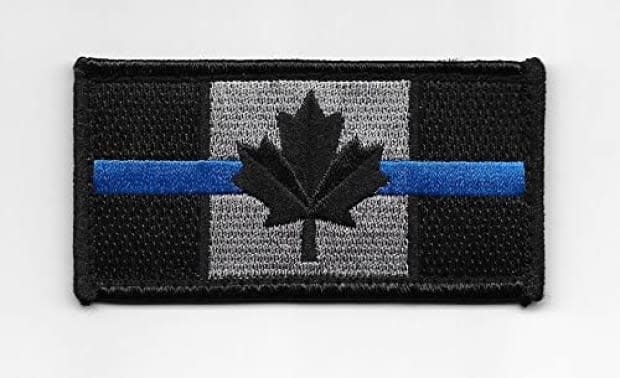Saint John police officers told not to wear thin blue line patches

The Saint John Police Force has informed its officers to stop wearing thin blue line patches following social media posts of officers sporting the controversial patch.
Tweets posted on Thursday show Saint John police officers wearing the patches at King's Square on July 3, while present at a protest being held by members of the community.
The patch has acquired various connotations, with some supporters saying wearing the patch is a sign of solidarity between officers while critics say it fosters a dangerous attitude of opposition between police officers and civilians.
Community members say the protest on July 3 was about bringing awareness to the damage being done by colonialism, following ongoing news of the graves of Indigenous children being found at the sites of former residential schools.
It also followed the vandalization of the statue of Sir Samuel Leonard Tilley in the square.
Saint John police declined an interview request and instead directed CBC News to its Twitter post.
The post states that uniform standards have been discussed with officers.
"[The Saint John Police Force] has uniform standards that only allow issued items on the uniform — the thin blue line patch is not issued by the [the Saint John Police Force] thus is not part of our uniform and not authorized to wear," the post said.
Cheryl Johnson is a Saint John resident who was at the protest and took the photos. She was alerted by a friend later in the month, who upon closer inspection, noticed some officers wearing the patches.
"It was horrifying to discover that," said Johnson in an interview.
Johnson said she considered informing Saint John police about the patches, but had concerns that the matter would be neglected, so she posted the photos to social media.
"I find that through Twitter, it can be very effective in quickly getting the message across and I was also interested to see what other folks thought about it," said Johnson.
"We know that in policing, there is a history of violence and abuse, assault, so trying to publicly double down on the concept of us versus them makes me feel incredibly unsafe."
Police forces across the country have distanced themselves from the patch.
The RCMP advised its officers to stop wearing the patches last fall, citing it was not an approved symbol or officially part of the uniform.
Ottawa police have also been banned from wearing the patches, while Montreal and Toronto police having been spotted wearing the patches this year.
Saint John Coun. David Hickey said he was disappointed to learn city police officers were wearing the patches.
"What it comes down to is promoting that us versus them mentality and rhetoric that is becoming apparent in policing and I don't want to see that," said Hickey.

He added that city officials have a duty to ensure Saint John residents feel comfortable interacting with their police department, but a shared level of respect needs to be achieved.
The wearing of thin blue line patches is facing additional scrutiny following protests in support of the Black Lives Matter movement and growing criticism toward the Blue Lives Matter counter movement, which began in the United States purporting the importance of valuing police officers' lives.
El Jones is an assistant professor of political studies at Mount Saint Vincent University and a community activist based in Halifax.
Jones said the patches migrated from the United States, with the messaging behind the thin blue line being that the police are the only thing standing between order and chaos.
"You see a kind of imagining of society that's quite dystopian.... You're always in danger and the only thing keeping you safe is policing," she said in an interview.

When looking at things through a lens of supposed order and chaos, Jones said often times policing punishes those who are already marginalized by society.
One of the most troubling connotations behind the patches, Jones noted, is them being worn in solidarity with officers accused of police brutality.
"Particularly to Black people, it is quite frightening because it's putting on your uniform, a sign of my solidarity with my fellow officers, and not with the idea of law and order," said Jones.
The patch has also served as conduit for racist ideology, with authorities acknowledging that white nationalist groups have taken an interest in adopting the patch as a symbol.

